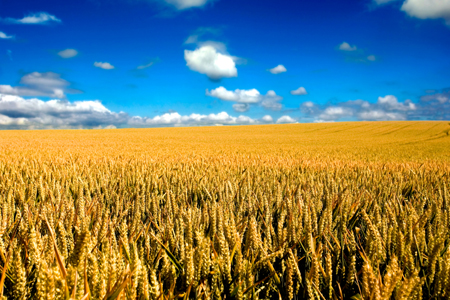Wheat Futures Decline in Overnight Trading; Fed’s Rate Increase May Affect Large Purchases
Category: Grains
 (Agriculture.com) – WHEAT LOWER OVERNIGHT AS SNOW FORECAST IN SOUTHERN PLAINS
(Agriculture.com) – WHEAT LOWER OVERNIGHT AS SNOW FORECAST IN SOUTHERN PLAINS
Wheat futures were lower in overnight trading as snowfall this weekend may cover plants that are currently exposed to the elements, making them prime targets for winterkill.
Temperatures overnight have been below freezing and are expected to stay low in parts of the Southern Plains into the weekend, according to the National Weather Service. Snowfall is expected in parts of central and western Kansas, northwestern Oklahoma, and northwestern Texas, providing a protective layer of snow for hard red winter wheat, MDA Information Services said in a report on Thursday.
Wheat futures for March delivery fell 3¾¢ to $4.14¼ a bushel on the Chicago Board of Trade. Kansas City futures declined 3¢ to $4.17 a bushel.
Corn and soybeans were little changed overnight as investors weigh demand against large global crop prospects.
Corn futures for March delivery declined a penny to $3.61 a bushel overnight.
Soybeans for January delivery fell ¾¢ to $10.23 a bushel. Soymeal futures for December delivery lost $1 to $311.80 a short ton, and soy oil added 0.23¢ to 37.15¢ a pound.
FEDERAL RESERVE’S INTEREST RATE HIKE MAY AFFECT COST OF LARGE PURCHASES
The Federal Reserve finally pulled the trigger and raised its base interest rate, the first increase in a year.
The Federal Open Markets Committee hiked the federal funds rate by 25 basis points from 0.5% to 0.75% on Wednesday, saying the economy is on stable enough ground to warrant an increase. The move was much anticipated, as the Fed had been toeing the line for the past several months.
The FOMC last raised rates in December 2015 and, at the time, had expected to increase interest four times in 2016. That didn’t happen, however, after global economic woes, the UK’s unexpected decision to leave the European Union, and the U.S. presidential election kept policymakers on the sidelines.
Declining unemployment along with a strong housing sector and rebounding crude oil prices eventually won the day, giving the FOMC the ammunition it needed to warrant a rate hike.
So what does that mean for the average Joe? Anybody looking to purchase a home, land, farm equipment, or other large-ticket items will pay more. The federal funds rate tends to only affect loans of more than five or six years, meaning it probably won’t impact the interest rate consumers get on their auto loans.
The Fed indicated it plans to raise interest rates three times next year, with the federal funds rate averaging about 1.4% in 2017, up from 0.6% this year. Most economists and analysts, however, have said they expect the FOMC to raise rates two times next year.
Either way, if you’re planning to get a new tract of land or a new piece of large farm equipment, expect to pay more in interest.
COLD WEATHER ENVELOPS MUCH OF NORTHERN U.S. AS STORM MOVES IN
Extremely cold weather will envelop much of the northern U.S. again today with wind chills reaching as low as -30˚F., according to the National Weather Service.
Much of the region’s lowest wind chill readings will be in the -20˚F. range, the NWS said in a report.
“This arctic air will push through the Plains and into the Ohio and Tennessee valleys toward the mid-Atlantic and Northeast by Thursday,” the NWS said. “Meanwhile, a series of Pacific storm systems will bring heavy rain and high-elevation snow to the West through the weekend.”
Along with the extreme cold, a winter storm is tracking across the Dakotas today and will push into parts of Minnesota and Wisconsin. The heaviest accumulations heading into the early part of the weekend will total about 9 inches, the NWS said.
Wind chills during that time will fall as low as -30˚F., according to the agency.




